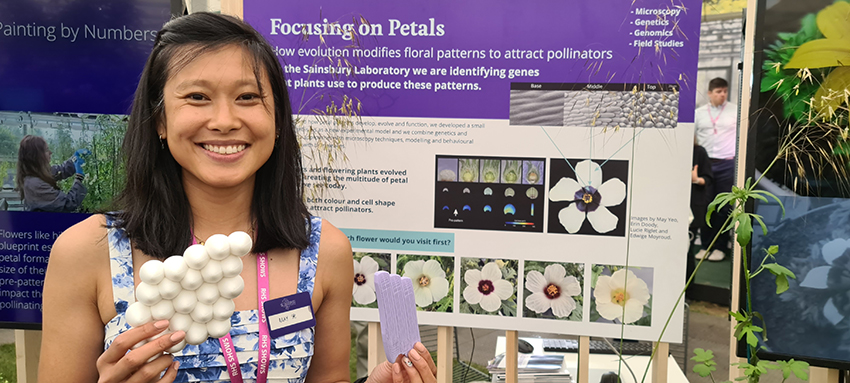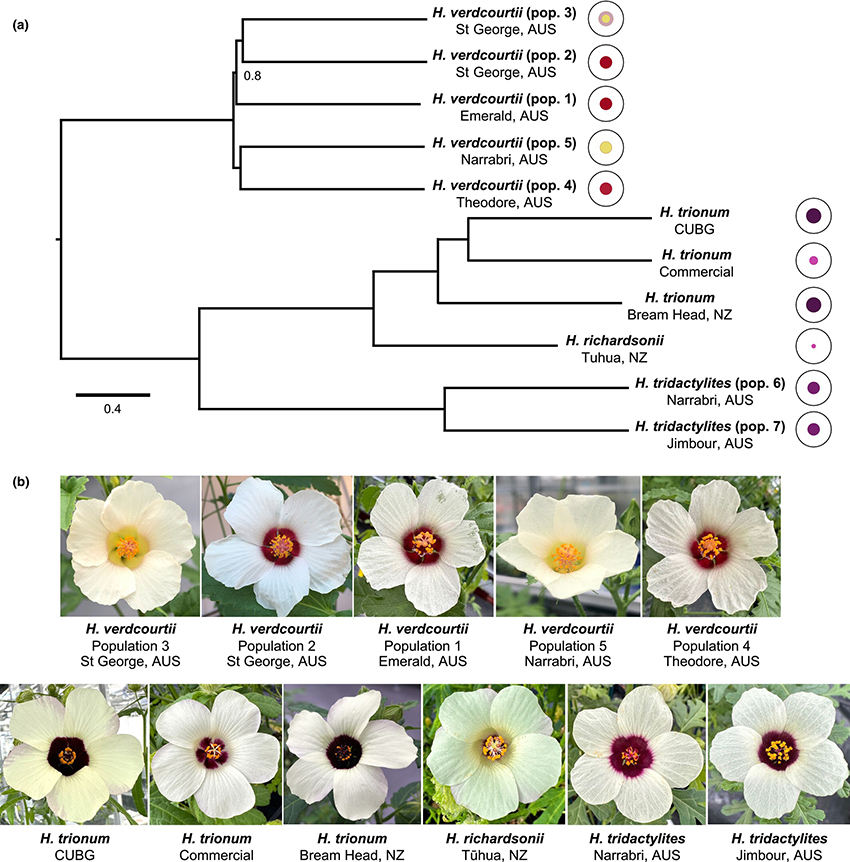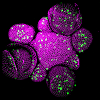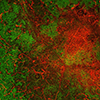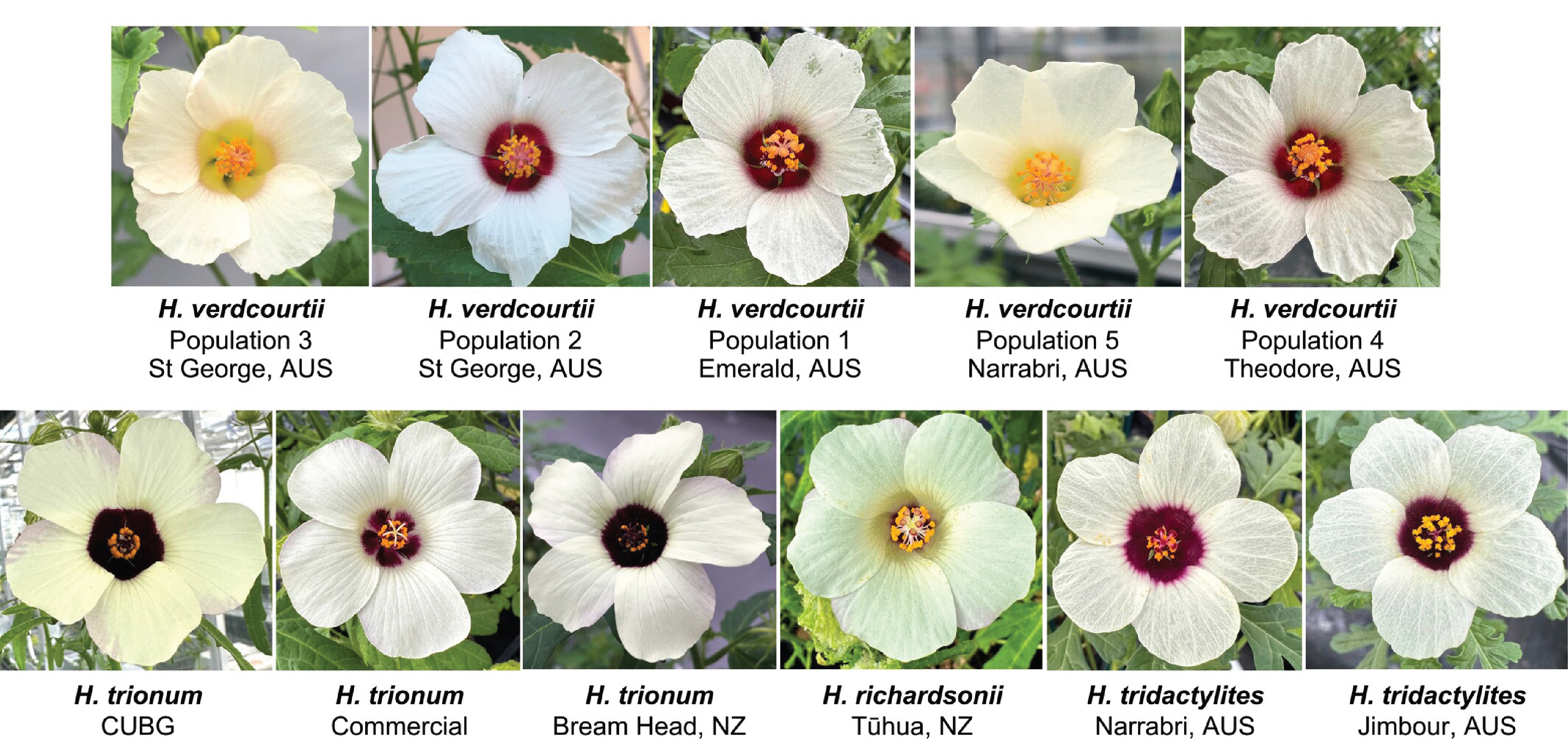
Cambridge scientists uncover the genetic pathways behind petal pattern evolution
New research reveals how repeated genetic changes in Hibiscus flowers have led to the loss of visually striking bullseye patterns despite their advantage in attracting pollinators like bumblebees.
Scientists at the Sainsbury Laboratory at the University of Cambridge have discovered that Hibiscus species with larger bullseye patterns on their petals are significantly more attractive to bumblebees. Yet intriguingly, many species have evolved to reduce or even lose these petal patterns altogether.
The study uncovers the genetic mechanisms behind this counterintuitive pattern loss and highlights how biodiversity can arise through repeated mutations in the same gene.
Published today (21 May 2025) in New Phytologist, the study identifies a gene, BERRY1, as a key regulator of bullseye formation in Hibiscus flowers. The team found that disruptions or deletions in this gene led to reduced or absent bullseyes in different species, demonstrating that similar floral changes can evolve independently through changes in a single genetic element.
“We found that bumblebees clearly prefer flowers with large, dark bullseyes, which act as visual guides directing them to the flower’s centre,” said May Yeo, first author and PhD student in Dr Edwige Moyroud’s group at the Sainsbury Laboratory. “It was surprising to discover that despite this preference, some Hibiscus species have repeatedly lost these features. This suggests that shifts in pollinators or environmental conditions may be selecting for these changes.”
In addition to providing a visual cue for pollinators, bullseye patterns in other species protect pollen grains from UV damage, so both ecological interactions and environmental pressures, such as UV exposure, shape how flowers evolve over time.
“Floral traits like bullseyes do more than look pretty—they have real impacts on plant reproduction and survival,” said Dr Edwige Moyroud, senior author and group leader at the Sainsbury Laboratory. “By tracing the genetics behind these petal patterns, we’re beginning to understand how relatively simple mutations can lead to major evolutionary changes.”
The team compared closely related species to reveal striking diversity in petal patterns: Hibiscus trionum flowers display large purple bullseyes, while H. richardsonii flowers show much smaller ones, and some H. verdcourtii flowers lack them altogether. In H. richardsonii, mutations in the BERRY1 gene disrupted anthocyanin production at the petal base. In H. verdcourtii, the gene is entirely missing, leading to complete pattern loss. These parallel genetic changes point to convergent evolution, where similar traits—or their loss—arise in different species through similar genetic routes.
Phylogenetic relationships between the Hibiscus species of the Trionum complex. (a) Phylogenetic tree highlighting relationships between species and populations. Unless stated, all nodes are perfectly supported. Branch lengths are shown in coalescent units. Each species is represented by a cartoon depicting bullseye size and color. (b) Representative flowers of each species/population emphasizing variation in bullseye size and color.
The researchers say their findings help explain how biodiversity is generated, particularly in flowering plants where visual cues are central to reproduction. Their work lays the foundation for further investigations into how genetic, ecological, and environmental factors interact to shape floral evolution.
“Understanding how floral colours and patterns have evolved gives us insight into broader questions about how diversity arises in nature,” added Yeo. “It also opens up possibilities for improving pollinator-friendly crops and supporting biodiversity in agricultural systems.”
Hibiscus petal patterning research featured in the RHS Chelsea Flower Show
The Moyroud Team’s research is being showcased this week at the world’s most famous flower show – the RHS Chelsea Flower Show. Two closely related Hibiscus species – one with a bullseye and one that has virtually lost its bullseye, and research findings on petal patterning together with live imaging from a scanning electron microscope and are on display.
Both May Yeo and Dr Edwige Moyroud are available for interview at the RHS Chelsea Flower Show on Tuesday 20 May (Dr Moyroud) and Wednesday 21 May (Yeo).
Reference
May T. S. Yeo, Alice L. M. Fairnie, Valentina Travaglia, Joseph F. Walker, Lucie Riglet, Selin Zeyrek and Edwige Moyroud (2025) The genetic basis of replicated bullseye pattern reduction across the Hibiscus trionum Complex, New Phytologist.
DOI: 10.1111/nph.70168
About New Phytologist
New Phytologist is a leading international journal focusing on high quality, original research across the broad spectrum of plant sciences, from intracellular processes through to global environmental change. The journal is owned by the New Phytologist Foundation, a not-for-profit organisation dedicated to the promotion of plant science. https://www.newphytologist.org/
Media contact
For interviews or further information, please contact:
Kathy Grube
Communications Manager,
Sainsbury Laboratory
Email: kjg45@cam.ac.uk
Mobile: 07709 783 168

